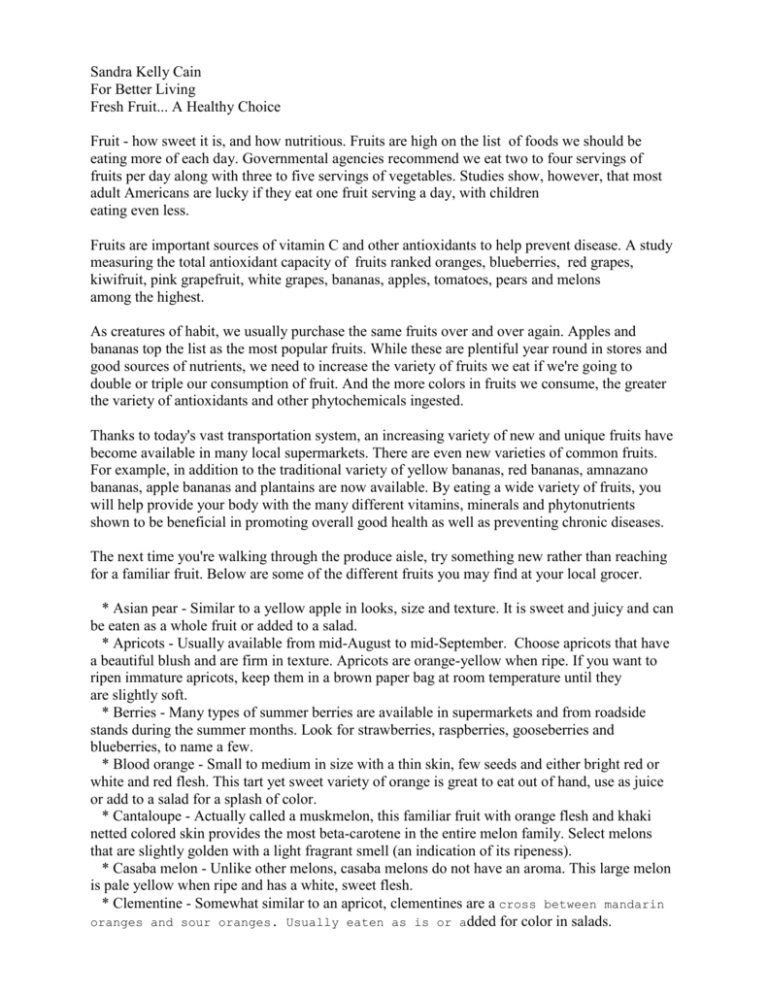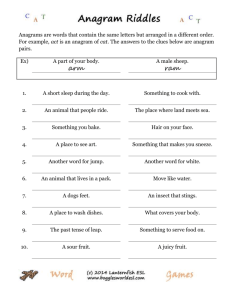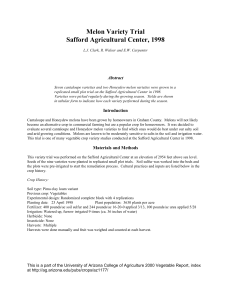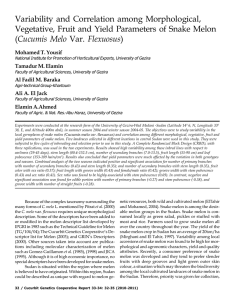Fresh Fruit
advertisement

Sandra Kelly Cain For Better Living Fresh Fruit... A Healthy Choice Fruit - how sweet it is, and how nutritious. Fruits are high on the list of foods we should be eating more of each day. Governmental agencies recommend we eat two to four servings of fruits per day along with three to five servings of vegetables. Studies show, however, that most adult Americans are lucky if they eat one fruit serving a day, with children eating even less. Fruits are important sources of vitamin C and other antioxidants to help prevent disease. A study measuring the total antioxidant capacity of fruits ranked oranges, blueberries, red grapes, kiwifruit, pink grapefruit, white grapes, bananas, apples, tomatoes, pears and melons among the highest. As creatures of habit, we usually purchase the same fruits over and over again. Apples and bananas top the list as the most popular fruits. While these are plentiful year round in stores and good sources of nutrients, we need to increase the variety of fruits we eat if we're going to double or triple our consumption of fruit. And the more colors in fruits we consume, the greater the variety of antioxidants and other phytochemicals ingested. Thanks to today's vast transportation system, an increasing variety of new and unique fruits have become available in many local supermarkets. There are even new varieties of common fruits. For example, in addition to the traditional variety of yellow bananas, red bananas, amnazano bananas, apple bananas and plantains are now available. By eating a wide variety of fruits, you will help provide your body with the many different vitamins, minerals and phytonutrients shown to be beneficial in promoting overall good health as well as preventing chronic diseases. The next time you're walking through the produce aisle, try something new rather than reaching for a familiar fruit. Below are some of the different fruits you may find at your local grocer. * Asian pear - Similar to a yellow apple in looks, size and texture. It is sweet and juicy and can be eaten as a whole fruit or added to a salad. * Apricots - Usually available from mid-August to mid-September. Choose apricots that have a beautiful blush and are firm in texture. Apricots are orange-yellow when ripe. If you want to ripen immature apricots, keep them in a brown paper bag at room temperature until they are slightly soft. * Berries - Many types of summer berries are available in supermarkets and from roadside stands during the summer months. Look for strawberries, raspberries, gooseberries and blueberries, to name a few. * Blood orange - Small to medium in size with a thin skin, few seeds and either bright red or white and red flesh. This tart yet sweet variety of orange is great to eat out of hand, use as juice or add to a salad for a splash of color. * Cantaloupe - Actually called a muskmelon, this familiar fruit with orange flesh and khaki netted colored skin provides the most beta-carotene in the entire melon family. Select melons that are slightly golden with a light fragrant smell (an indication of its ripeness). * Casaba melon - Unlike other melons, casaba melons do not have an aroma. This large melon is pale yellow when ripe and has a white, sweet flesh. * Clementine - Somewhat similar to an apricot, clementines are a cross between mandarin oranges and sour oranges. Usually eaten as is or added for color in salads. * Crenshaw melon - These melons can weigh up to 10 pounds and deliver a unique sweet and spicy flavor. They are a hybrid between the casaba and Persian melon with a yellowish skin and salmon-colored flesh. * Guava - About the size of a lemon with a peel that varies in color from yellow to purple and flesh that can be yellow, pink or red. With its sweet taste, guavas are great as a whole fruit, or can be used in salads, juices or frozen desserts. * Honeydew melon - The sweetest of all the melons and averaging 5 to 6 pounds, honeydew melons have a creamy yellow rind when ripe and pale green flesh. * Kumquat - A very hardy citrus fruit that looks like a small, olive-shaped orange. Kumquats are entirely edible and often are cooked with meat, poultry or fish. * Papaya - A tart yet sweet fruit with an inedible yellow or orange peel and orange fruit with black seeds inside. Can be eaten as is or mixed in salads. * Passion fruit - A small fruit with a leathery peel that may appear shriveled. It has a sweet-tart flavor and can be eaten out of hand or added to beverages, sauces or salads. * Peaches and pears - Nothing tastes better in August than a plump juicy peach or pear straight from the tree or produce stand. Buy extra to can or make into jams or salsas. * Plums -Usually available in August. Choose plums that have a beautiful blush and are firm in texture. * Starfruit - When sliced, this unique fruit forms a star shape. Its flavor varies from sweet to tart. In addition to be eaten as a whole fruit, starfruit makes a great garnish. * Ugli fruit - A cross between a tangerine and a grapefruit, ugli fruit looks like a small grapefruit on the outside and is sectioned inside. Source: Colorado Cooperative Extension Pear Compote 6 firm ripe pears, peeled, cored and cut into quarters 1 can (16 ozs.) whole-berry cranberry sauce 1/4 cup sugar 1 tablespoon lemon juice 1/4 teaspoon ground cinnamon 1/4 teaspoon ground ginger 2 medium navel oranges, peeled, cut into 8 slices and halved In a 9 x 13 baking dish coated with nonstick cooking spray, arrange pears. In a saucepan, combine the cranberry sauce, sugar, lemon juice, cinnamon and ginger. Cook and stir until mixture comes to a boil. Pour over pears. Top with oranges. Cover and bake at 350 degrees for 30 - 35 minutes or until pears are tender. Serve warm.










